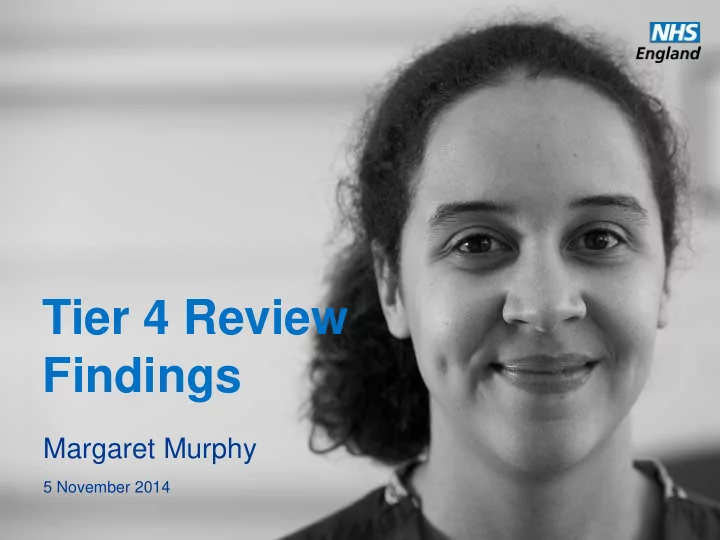

Tier 4 Review Findings Margaret Murphy 5 November 2014 www.england.nhs.uk
Commissioning Tier 4 CAMHS Services • Following passage of HSC Act responsibility for commissioning tier 4 CAMHS inpatient services and some highly specialised ASD services transferred to NHS England from April 2013 (became so-called prescribed services) • Some Tier 4 CAMHS previously nationally commissioned – bid for Tier 4 CAMHS children’s units to be nationally commissioned • Pre April 2013 – variable arrangements for much of Tier 4 – from ‘spot purchasing’ to areas where groups of PCTs/SCG collaborated to commission the care pathway www.england.nhs.uk
The Tier 4 Review • Commissioned by the specialised commissioning oversight group (SCOG) within NHS England to provide more accurate picture of the current usage of Tier 4 and issues for inpatient services • Focus on Tier 4 CAMHS for practical reasons although with an understanding that Tier 3 and social care issues impact • Aim was to describe the current situation and analyse data from providers and commissioners to inform any further work www.england.nhs.uk
Reasons for the Review • Concerns re quality/safety in some providers • Concerns re access (i.e. capacity, availability, timeliness, distance from home for some children and young people) www.england.nhs.uk
The method • Independent steering group • Data collection and analysis was led by the CCQI • A survey was sent out to all inpatient CAMHS providers in England – where possible compared 2012-13 and 2013-14 data • Ten area team leads who look after specialised commissioning also completed 10 case studies following patient journeys (100 in total) www.england.nhs.uk
How many beds are there in England? • In 2014 - 1264 beds identified in the report commissioned by NHS England • These are: 618 General CAMHS 232 Eating disorders 141 Low secure 92 Learning disability 92 PICU 47 HDU 42 Medium secure • An additional 65 un-commissioned beds nationally (mostly over 13s general CAMHS and ED) www.england.nhs.uk
Who was admitted? Case history information – number of cases Yes No Don’t know Young Person had had a previous Tier 4 admission 38 60 2 Young Person was known to social services 47 53 3 Looked After Child 13 87 www.england.nhs.uk
What’s their primary diagnosis? www.england.nhs.uk
Length of stay www.england.nhs.uk
Main Issues for Inpatient CAMHS www.england.nhs.uk
Referrals www.england.nhs.uk
Admissions www.england.nhs.uk
Bed Occupancy www.england.nhs.uk
Main reasons given by provides for inappropriate admissions www.england.nhs.uk
Delayed discharges www.england.nhs.uk
Most common causes of delayed discharges www.england.nhs.uk
Bed closures during 2013 www.england.nhs.uk
How many young people travel out of area for a bed? www.england.nhs.uk
Out of area placements • No reliable data from the old commissioning arrangements to compare with • Those who travelled over 100 miles were predominantly from large geographical areas with limited bed provision – this would have been the same before the change to specialised commissioning • Of 37 from commissioner case studies admitted out of area, 13 required a specialist bed www.england.nhs.uk
What has happened since the review ? • Appointment of case managers – evidence that they have improved ‘flow’ through the system • Increase in number of general and PICU beds in areas identified as being underprovided • Weekly update shows there are now more beds available nationally although there are fluctuations in need experienced by areas and in particular fluctuations in sub speciality needs • Introduction of standardised referral / access assessments (to ensure greater consistency) • Weekly update shows there are now more beds available nationally although there are fluctuations in need experienced by areas and in particular fluctuations in sub speciality needs • Co-commissioning pilots • Future in Mind www.england.nhs.uk
Why eating disorders transformation ? • Evidence that effective community treatments • BUT still reliance in many areas on inpatient care • COULD WE BOTH IMPROVE OUTCOMES and MAKE MORE EFFECTIVE USE OF INPATIENT CAPACITY ?? www.england.nhs.uk
Recommend
More recommend